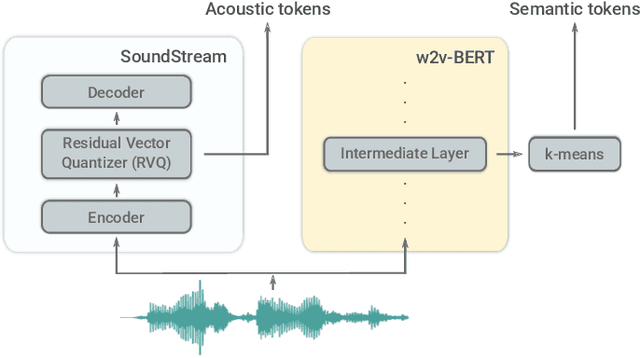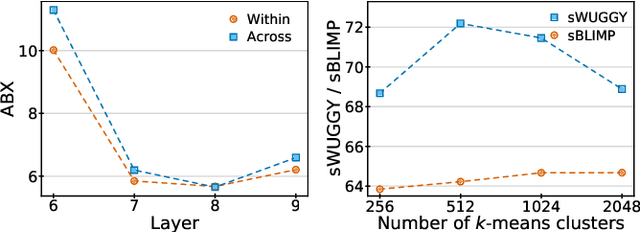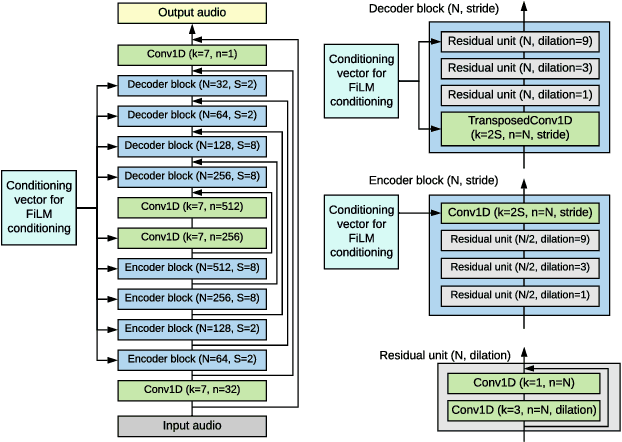Marco Tagliasacchi
MAD Speech: Measures of Acoustic Diversity of Speech
Apr 16, 2024



Abstract:Generative spoken language models produce speech in a wide range of voices, prosody, and recording conditions, seemingly approaching the diversity of natural speech. However, the extent to which generated speech is acoustically diverse remains unclear due to a lack of appropriate metrics. We address this gap by developing lightweight metrics of acoustic diversity, which we collectively refer to as MAD Speech. We focus on measuring five facets of acoustic diversity: voice, gender, emotion, accent, and background noise. We construct the metrics as a composition of specialized, per-facet embedding models and an aggregation function that measures diversity within the embedding space. Next, we build a series of datasets with a priori known diversity preferences for each facet. Using these datasets, we demonstrate that our proposed metrics achieve a stronger agreement with the ground-truth diversity than baselines. Finally, we showcase the applicability of our proposed metrics across several real-life evaluation scenarios. MAD Speech will be made publicly accessible.
Gemini 1.5: Unlocking multimodal understanding across millions of tokens of context
Mar 08, 2024Abstract:In this report, we present the latest model of the Gemini family, Gemini 1.5 Pro, a highly compute-efficient multimodal mixture-of-experts model capable of recalling and reasoning over fine-grained information from millions of tokens of context, including multiple long documents and hours of video and audio. Gemini 1.5 Pro achieves near-perfect recall on long-context retrieval tasks across modalities, improves the state-of-the-art in long-document QA, long-video QA and long-context ASR, and matches or surpasses Gemini 1.0 Ultra's state-of-the-art performance across a broad set of benchmarks. Studying the limits of Gemini 1.5 Pro's long-context ability, we find continued improvement in next-token prediction and near-perfect retrieval (>99%) up to at least 10M tokens, a generational leap over existing models such as Claude 2.1 (200k) and GPT-4 Turbo (128k). Finally, we highlight surprising new capabilities of large language models at the frontier; when given a grammar manual for Kalamang, a language with fewer than 200 speakers worldwide, the model learns to translate English to Kalamang at a similar level to a person who learned from the same content.
TokenSplit: Using Discrete Speech Representations for Direct, Refined, and Transcript-Conditioned Speech Separation and Recognition
Aug 21, 2023


Abstract:We present TokenSplit, a speech separation model that acts on discrete token sequences. The model is trained on multiple tasks simultaneously: separate and transcribe each speech source, and generate speech from text. The model operates on transcripts and audio token sequences and achieves multiple tasks through masking of inputs. The model is a sequence-to-sequence encoder-decoder model that uses the Transformer architecture. We also present a "refinement" version of the model that predicts enhanced audio tokens from the audio tokens of speech separated by a conventional separation model. Using both objective metrics and subjective MUSHRA listening tests, we show that our model achieves excellent performance in terms of separation, both with or without transcript conditioning. We also measure the automatic speech recognition (ASR) performance and provide audio samples of speech synthesis to demonstrate the additional utility of our model.
AudioPaLM: A Large Language Model That Can Speak and Listen
Jun 22, 2023



Abstract:We introduce AudioPaLM, a large language model for speech understanding and generation. AudioPaLM fuses text-based and speech-based language models, PaLM-2 [Anil et al., 2023] and AudioLM [Borsos et al., 2022], into a unified multimodal architecture that can process and generate text and speech with applications including speech recognition and speech-to-speech translation. AudioPaLM inherits the capability to preserve paralinguistic information such as speaker identity and intonation from AudioLM and the linguistic knowledge present only in text large language models such as PaLM-2. We demonstrate that initializing AudioPaLM with the weights of a text-only large language model improves speech processing, successfully leveraging the larger quantity of text training data used in pretraining to assist with the speech tasks. The resulting model significantly outperforms existing systems for speech translation tasks and has the ability to perform zero-shot speech-to-text translation for many languages for which input/target language combinations were not seen in training. AudioPaLM also demonstrates features of audio language models, such as transferring a voice across languages based on a short spoken prompt. We release examples of our method at https://google-research.github.io/seanet/audiopalm/examples
SoundStorm: Efficient Parallel Audio Generation
May 16, 2023Abstract:We present SoundStorm, a model for efficient, non-autoregressive audio generation. SoundStorm receives as input the semantic tokens of AudioLM, and relies on bidirectional attention and confidence-based parallel decoding to generate the tokens of a neural audio codec. Compared to the autoregressive generation approach of AudioLM, our model produces audio of the same quality and with higher consistency in voice and acoustic conditions, while being two orders of magnitude faster. SoundStorm generates 30 seconds of audio in 0.5 seconds on a TPU-v4. We demonstrate the ability of our model to scale audio generation to longer sequences by synthesizing high-quality, natural dialogue segments, given a transcript annotated with speaker turns and a short prompt with the speakers' voices.
LMCodec: A Low Bitrate Speech Codec With Causal Transformer Models
Mar 23, 2023Abstract:We introduce LMCodec, a causal neural speech codec that provides high quality audio at very low bitrates. The backbone of the system is a causal convolutional codec that encodes audio into a hierarchy of coarse-to-fine tokens using residual vector quantization. LMCodec trains a Transformer language model to predict the fine tokens from the coarse ones in a generative fashion, allowing for the transmission of fewer codes. A second Transformer predicts the uncertainty of the next codes given the past transmitted codes, and is used to perform conditional entropy coding. A MUSHRA subjective test was conducted and shows that the quality is comparable to reference codecs at higher bitrates. Example audio is available at https://mjenrungrot.github.io/chrome-media-audio-papers/publications/lmcodec.
Speak, Read and Prompt: High-Fidelity Text-to-Speech with Minimal Supervision
Feb 07, 2023Abstract:We introduce SPEAR-TTS, a multi-speaker text-to-speech (TTS) system that can be trained with minimal supervision. By combining two types of discrete speech representations, we cast TTS as a composition of two sequence-to-sequence tasks: from text to high-level semantic tokens (akin to "reading") and from semantic tokens to low-level acoustic tokens ("speaking"). Decoupling these two tasks enables training of the "speaking" module using abundant audio-only data, and unlocks the highly efficient combination of pretraining and backtranslation to reduce the need for parallel data when training the "reading" component. To control the speaker identity, we adopt example prompting, which allows SPEAR-TTS to generalize to unseen speakers using only a short sample of 3 seconds, without any explicit speaker representation or speaker-id labels. Our experiments demonstrate that SPEAR-TTS achieves a character error rate that is competitive with state-of-the-art methods using only 15 minutes of parallel data, while matching ground-truth speech in terms of naturalness and acoustic quality, as measured in subjective tests.
MusicLM: Generating Music From Text
Jan 26, 2023



Abstract:We introduce MusicLM, a model generating high-fidelity music from text descriptions such as "a calming violin melody backed by a distorted guitar riff". MusicLM casts the process of conditional music generation as a hierarchical sequence-to-sequence modeling task, and it generates music at 24 kHz that remains consistent over several minutes. Our experiments show that MusicLM outperforms previous systems both in audio quality and adherence to the text description. Moreover, we demonstrate that MusicLM can be conditioned on both text and a melody in that it can transform whistled and hummed melodies according to the style described in a text caption. To support future research, we publicly release MusicCaps, a dataset composed of 5.5k music-text pairs, with rich text descriptions provided by human experts.
AudioLM: a Language Modeling Approach to Audio Generation
Sep 07, 2022



Abstract:We introduce AudioLM, a framework for high-quality audio generation with long-term consistency. AudioLM maps the input audio to a sequence of discrete tokens and casts audio generation as a language modeling task in this representation space. We show how existing audio tokenizers provide different trade-offs between reconstruction quality and long-term structure, and we propose a hybrid tokenization scheme to achieve both objectives. Namely, we leverage the discretized activations of a masked language model pre-trained on audio to capture long-term structure and the discrete codes produced by a neural audio codec to achieve high-quality synthesis. By training on large corpora of raw audio waveforms, AudioLM learns to generate natural and coherent continuations given short prompts. When trained on speech, and without any transcript or annotation, AudioLM generates syntactically and semantically plausible speech continuations while also maintaining speaker identity and prosody for unseen speakers. Furthermore, we demonstrate how our approach extends beyond speech by generating coherent piano music continuations, despite being trained without any symbolic representation of music.
Text-Driven Separation of Arbitrary Sounds
Apr 12, 2022



Abstract:We propose a method of separating a desired sound source from a single-channel mixture, based on either a textual description or a short audio sample of the target source. This is achieved by combining two distinct models. The first model, SoundWords, is trained to jointly embed both an audio clip and its textual description to the same embedding in a shared representation. The second model, SoundFilter, takes a mixed source audio clip as an input and separates it based on a conditioning vector from the shared text-audio representation defined by SoundWords, making the model agnostic to the conditioning modality. Evaluating on multiple datasets, we show that our approach can achieve an SI-SDR of 9.1 dB for mixtures of two arbitrary sounds when conditioned on text and 10.1 dB when conditioned on audio. We also show that SoundWords is effective at learning co-embeddings and that our multi-modal training approach improves the performance of SoundFilter.
 Add to Chrome
Add to Chrome Add to Firefox
Add to Firefox Add to Edge
Add to Edge